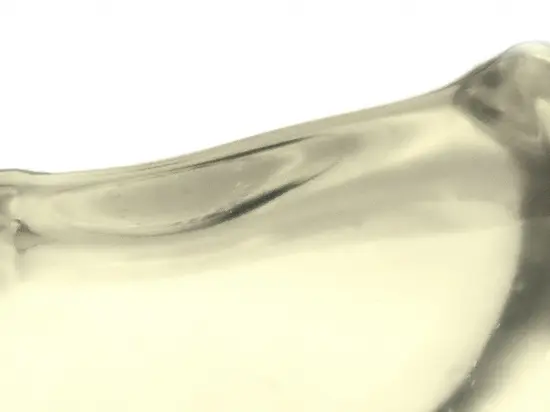
Chondrus crispus
- Trace elements
- Vitamin A, E, F and K
- Calcium
- Potassium
- Iodine
On request

Typical applications: Chondrus crispus
Typical applications
Chondrus crispus, also known as "Irish moss", is a red alga that occurs on the North Atlantic coasts, but also on the North and Baltic Seas.
Due to its natural properties as a thickening agent, Chondrus crispus is used to obtain carrageenan, a thickening agent used in the food industry as a vegetable gelatine substitute.
Apart from its properties as a thickening agent, cartilaginous kelp has also been used as a food and animal feed since time immemorial.
Due to its antiviral and antimicrobial effect it helps the skin to regulate its microbiome. But Chondrus crispus is not only useful for the skin but also for the hair, it gives it strength and shine due to the many healthy ingredients[4, 5, 6, 7, 8, 9].
The liquid is usually used in the production of cosmetics and aquaristics.
This product is available in the following forms of liquid extracts:
- Water-glycerin extract
The product is also available as powder.
Typical applications in the cosmetics industry:
Chondrus crispus offers itself as an antioxidant and also acts as an anti-inflammatory protective agent[11].
The versatile nutrient profile of minerals, amino acids and vitamins is absorbed and accumulated by the skin during application. All the ingredients have a positive effect on the appearance of the skin.
Due to its occlusive properties of natural polysaccharides, peptides, amino acids and carrageenan, which help the skin retain its moisture content, it is well suited for use in moisturizers and lotions.
Sources
- M.D. Guiry in Guiry, M.D. & Guiry, G.M. 17 February 2020. AlgaeBase. World-wide electronic publication, National University of Ireland, Galway. (https://www.algaebase.org/search/species/detail/?species_id=19519)
- Chondrus crispus - Wikipedia (https://en.wikipedia.org/wiki/Chondrus_crispus)
- Park SJ, Sharma A, Lee HJ. An Update on the Chemical Constituents and Biological Properties of Selected Species of an Underpinned Genus of Red Algae: Chondrus. Mar Drugs. 2024 Jan 17;22(1):47. doi: 10.3390/md22010047. PMID: 38248672; PMCID: PMC10817618. (https://pubmed.ncbi.nlm.nih.gov/38248672/)
- Kulshreshtha G, Burlot AS, Marty C, Critchley A, Hafting J, Bedoux G, Bourgougnon N, Prithiviraj B. Enzyme-assisted extraction of bioactive material from Chondrus crispus and Codium fragile and its effect on herpes simplex virus (HSV-1). Mar Drugs. 2015 Jan 16;13(1):558-80. doi: 10.3390/md13010558. PMID: 25603348; PMCID: PMC4306952. (https://pubmed.ncbi.nlm.nih.gov/25603348/)
- Kalitnik AA, Marcov PA, Anastyuk SD, Barabanova AO, Glazunov VP, Popov SV, Ovodov YS, Yermak IM. Gelling polysaccharide from Chondrus armatus and its oligosaccharides: the structural peculiarities and anti-inflammatory activity. Carbohydr Polym. 2015 Jan 22;115:768-75. doi: 10.1016/j.carbpol.2014.04.070. Epub 2014 Apr 26. PMID: 25439960. (https://pubmed.ncbi.nlm.nih.gov/25439960/)
- Levy-Ontman O, Abu-Galiyun E, Huleihel M. Studying the Relationship between the Antiviral Activity and the Structure of ἰ-Carrageenan Using Ultrasonication. Int J Mol Sci. 2023 Sep 17;24(18):14200. doi: 10.3390/ijms241814200. PMID: 37762503; PMCID: PMC10531741. (https://pubmed.ncbi.nlm.nih.gov/37762503/)
- Frediansyah A. The antiviral activity of iota-, kappa-, and lambda-carrageenan against COVID-19: A critical review. Clin Epidemiol Glob Health. 2021 Oct-Dec;12:100826. doi: 10.1016/j.cegh.2021.100826. Epub 2021 Jun 29. PMID: 34222718; PMCID: PMC8240443. (https://pubmed.ncbi.nlm.nih.gov/34222718/)
- Zhu M, Ge L, Lyu Y, Zi Y, Li X, Li D, Mu C. Preparation, characterization and antibacterial activity of oxidized κ-carrageenan. Carbohydr Polym. 2017 Oct 15;174:1051-1058. doi: 10.1016/j.carbpol.2017.07.029. Epub 2017 Jul 13. PMID: 28821027. (https://pubmed.ncbi.nlm.nih.gov/28821027/)
- Liu J, Kandasamy S, Zhang J, Kirby CW, Karakach T, Hafting J, Critchley AT, Evans F, Prithiviraj B. Prebiotic effects of diet supplemented with the cultivated red seaweed Chondrus crispus or with fructo-oligo-saccharide on host immunity, colonic microbiota and gut microbial metabolites. BMC Complement Altern Med. 2015 Aug 14;15:279. doi: 10.1186/s12906-015-0802-5. PMID: 26271359; PMCID: PMC4535385. (https://pubmed.ncbi.nlm.nih.gov/26271359/)
- López-Hortas L, Torres MD, Falqué E, Domínguez H. Physicochemical Evaluation of Personal Care Products Developed with Chondrus crispus Fractions Processed by Ecofriendly Methodologies. Mar Drugs. 2022 Nov 6;20(11):695. doi: 10.3390/md20110695. PMID: 36355018; PMCID: PMC9692426. (https://pubmed.ncbi.nlm.nih.gov/36355018/)
- Premarathna AD, Ahmed TAE, Rjabovs V, Hammami R, Critchley AT, Tuvikene R, Hincke MT. Immunomodulation by xylan and carrageenan-type polysaccharides from red seaweeds: Anti-inflammatory, wound healing, cytoprotective, and anticoagulant activities. Int J Biol Macromol. 2024 Mar;260(Pt 1):129433. doi: 10.1016/j.ijbiomac.2024.129433. Epub 2024 Jan 15. PMID: 38232891. (https://pubmed.ncbi.nlm.nih.gov/38232891/)
- Andersen S, Noahsen P, Rex KF, Florian-Sørensen HC, Mulvad G. Iodine in Edible Seaweed, Its Absorption, Dietary Use, and Relation to Iodine Nutrition in Arctic People. J Med Food. 2019 Apr;22(4):421-426. doi: 10.1089/jmf.2018.0187. PMID: 30990756. (https://pubmed.ncbi.nlm.nih.gov/30990756/)
Reply within twelve hours